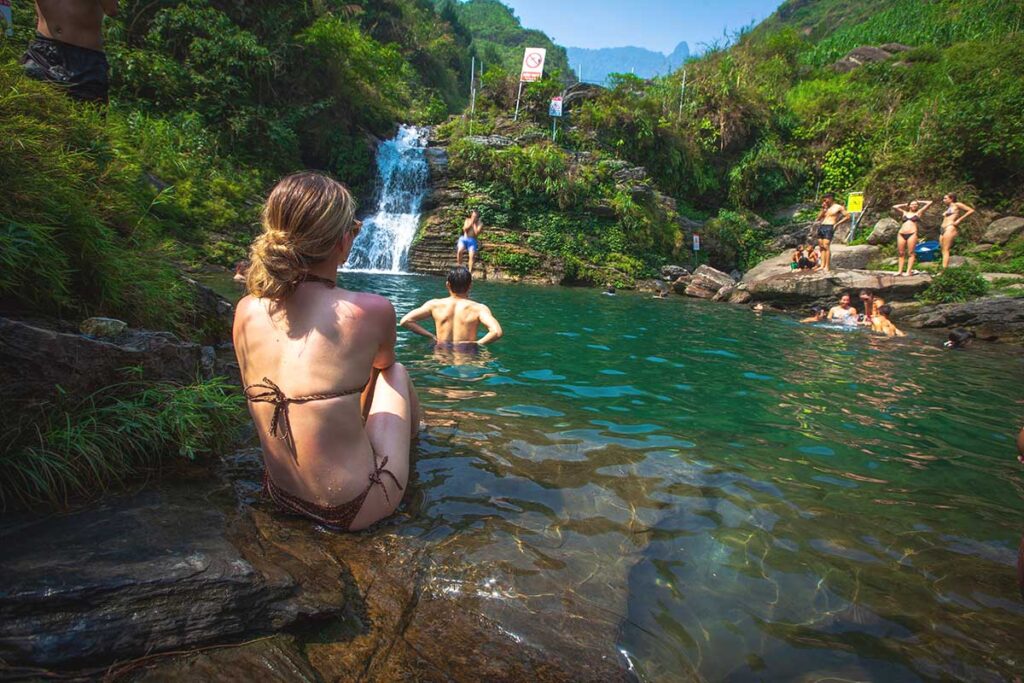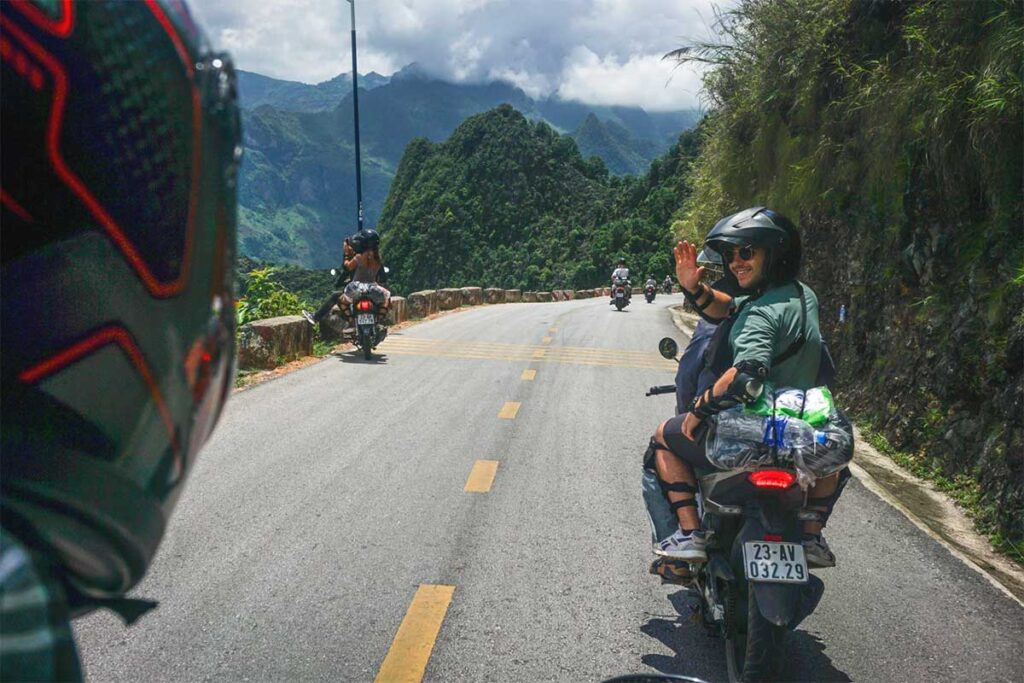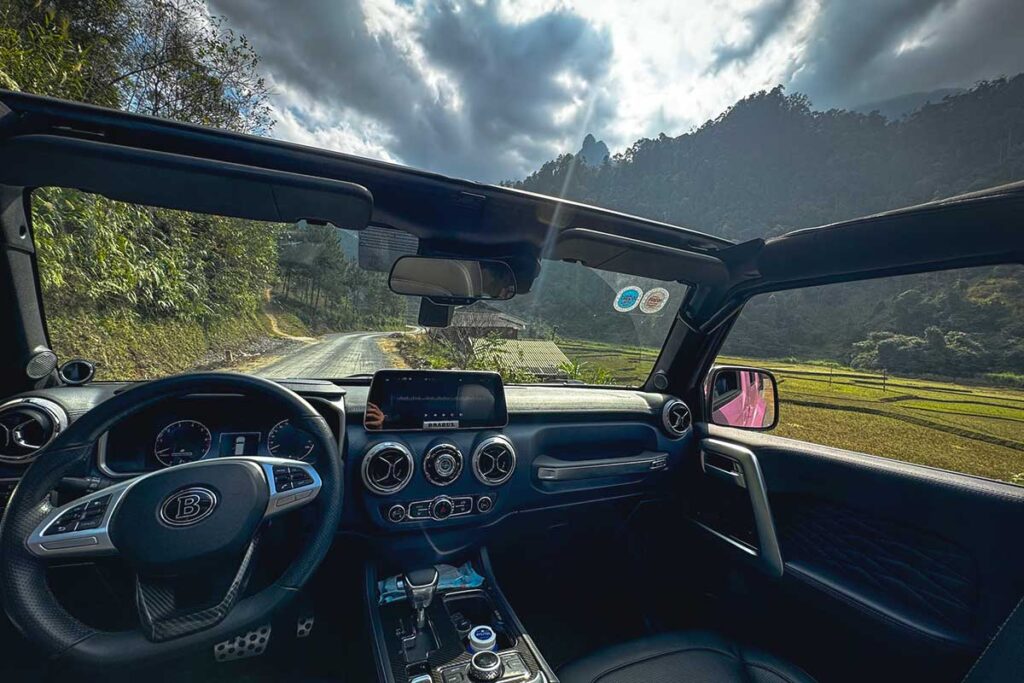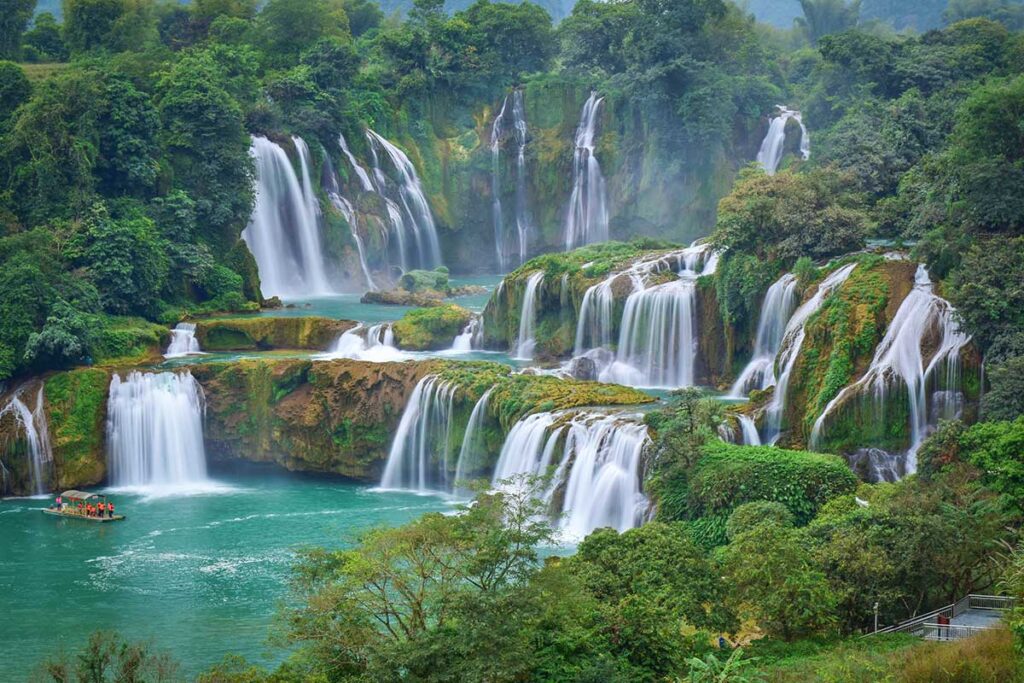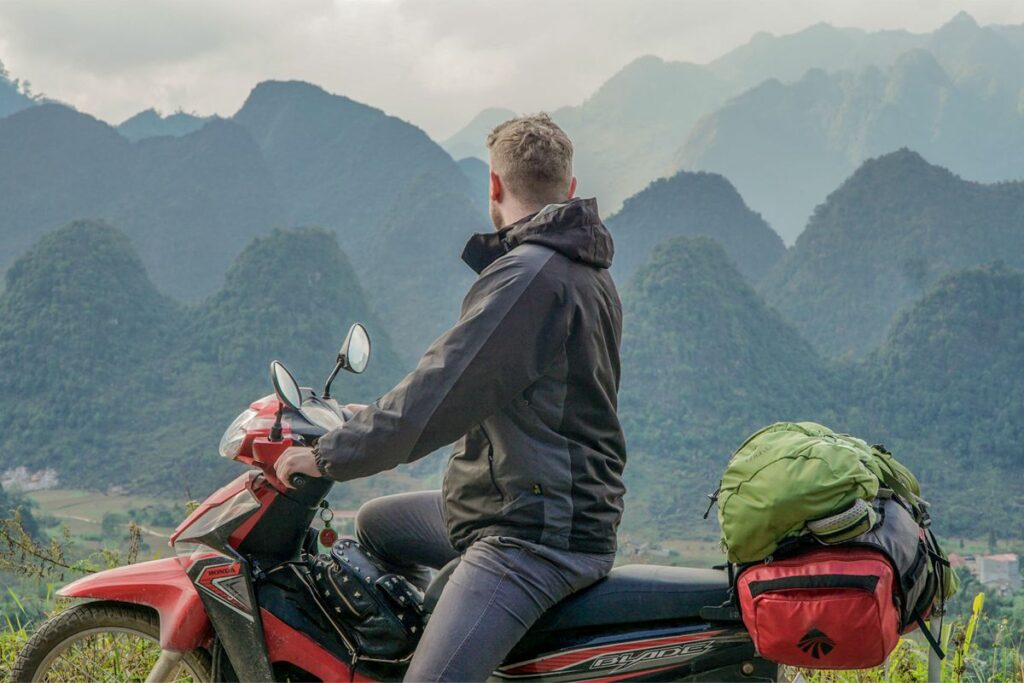Best time to visit waterfalls in Ha Giang
Before planning which waterfalls to visit along the Ha Giang Loop, it’s important to understand how the seasons affect them. Water levels in the region change a lot throughout the year — some waterfalls completely dry up during the wrong season.
The best time to see waterfalls in Ha Giang is during the rainy season (May to September) and the early dry season (October and November). This is when the falls are at their strongest, and the surrounding scenery is at its greenest. In fact, during peak rainy months, you’ll often spot temporary waterfalls pouring down the cliffs right along the roadside — a dramatic bonus to the journey.
From late December to April, rainfall drops significantly. Many waterfalls become much smaller, and some dry up entirely, especially those that rely on rainfall rather than spring-fed streams. If waterfalls are a highlight for your trip, avoid this time or focus on the ones that flow year-round.
Best waterfalls along the Ha Giang Loop
While riding the Ha Giang Loop, you’ll often spot waterfalls spilling down the cliffs along the roadside — especially in the rainy season. Most of these aren’t marked and are easy to miss if you’re not paying attention. But a few have become popular stops, offering a refreshing break or a swim in a jungle setting. Below are four of the best-known and easiest-to-reach waterfalls along the loop.
1. Du Gia Waterfall
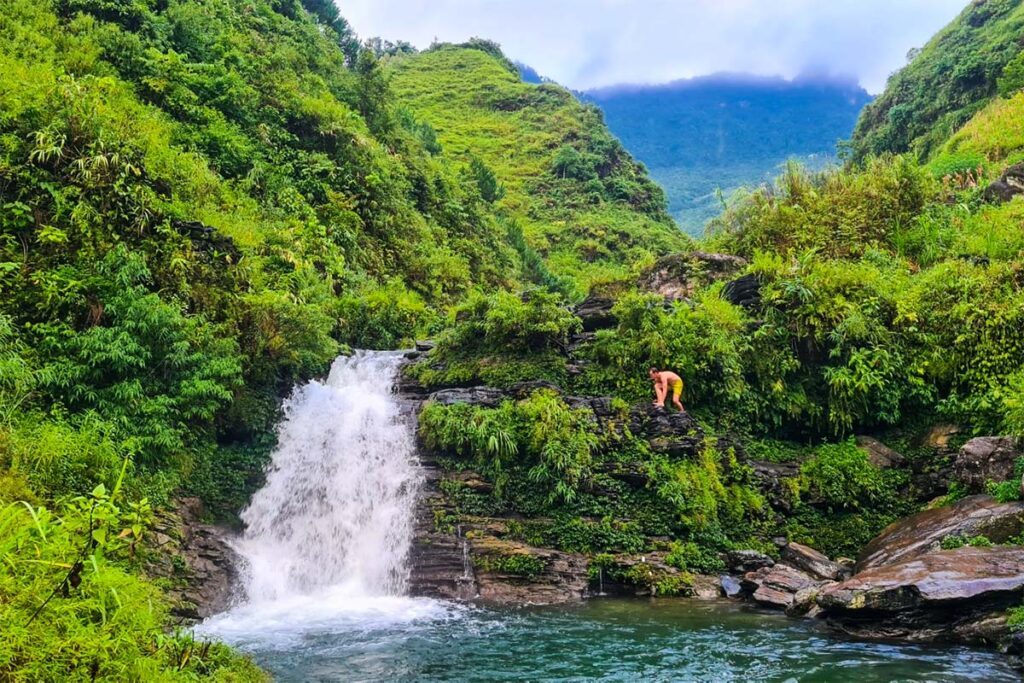
Located just outside the village of Du Gia, this is easily the most popular waterfall on the Ha Giang Loop. Du Gia itself is a peaceful village surrounded by rice fields, known for its relaxed vibe and local homestays. Most loop itineraries include an overnight here, and a stop at the waterfall is often the final reward after a day of riding.
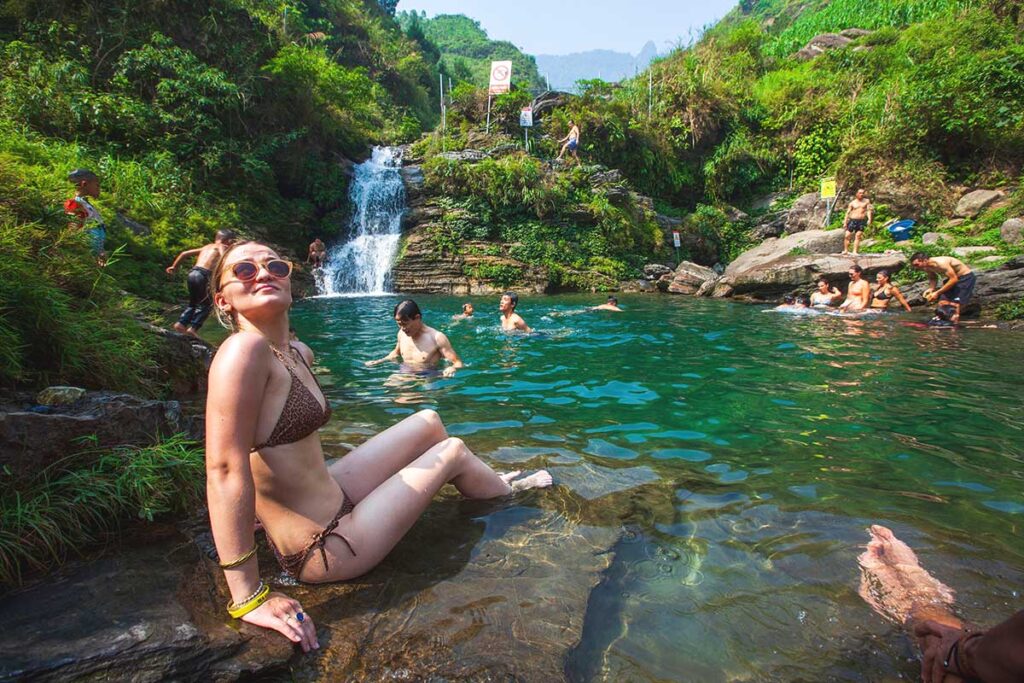
The waterfall isn’t massive, but the natural plunge pool is the main draw. You can swim, relax by the water, or jump in from the rocks above. It’s especially lively in the late afternoon when tour groups arrive to cool off. Expect a social scene, with music, drinks, and sometimes a small bar selling towels and refreshments nearby.
If you prefer a quieter experience, go early in the morning before the crowds arrive. You can ride your motorbike almost all the way to the entrance — don’t let nearby cafés convince you to park early. The short walk to the falls is easy, and there’s no official entrance fee (a small donation is optional).
Travel Tip: Google Maps might lead you down a rough road. Look for the paved turn-off in the village near the cluster of restaurants.
2. Nai Nam Dam Waterfall
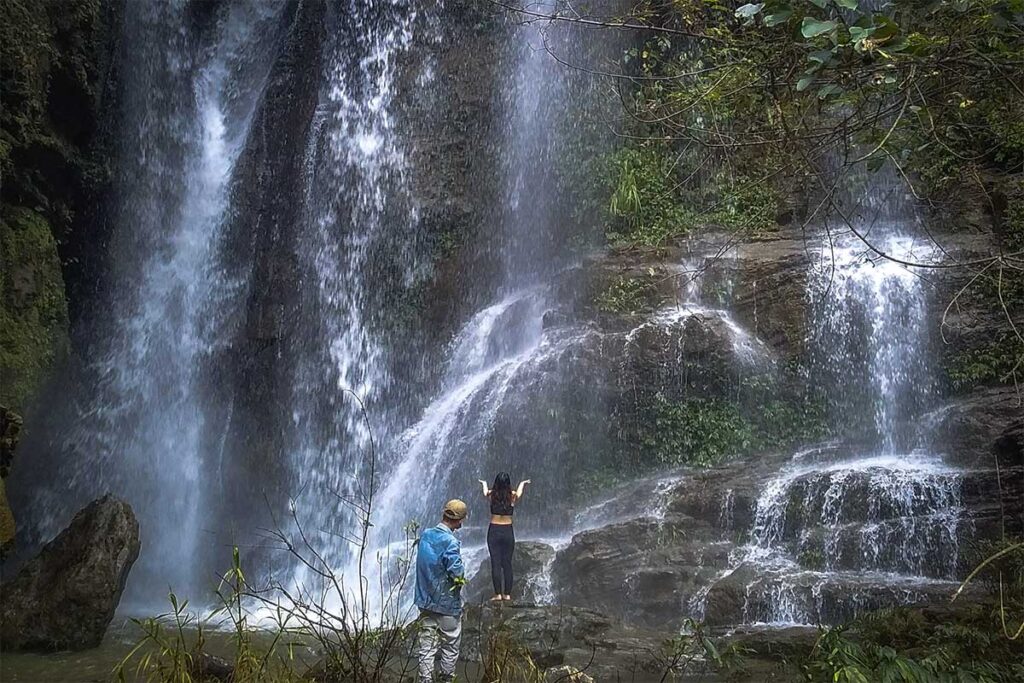
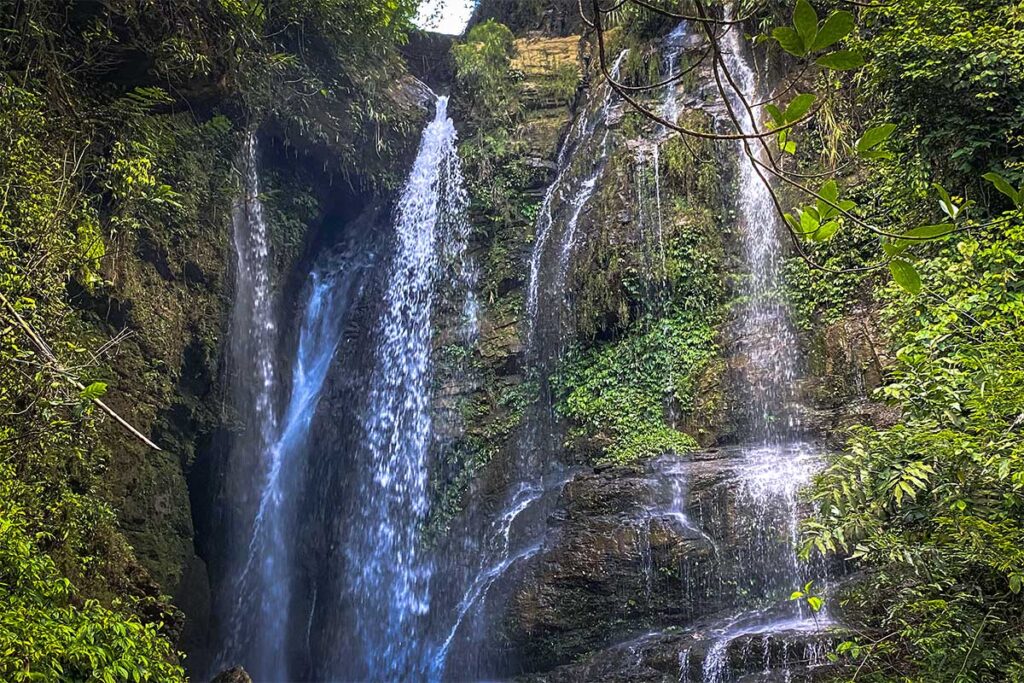
This hidden waterfall sits just behind Nam Dam village, a Red Dao ethnic village near Quan Ba. It’s only a short detour off the loop and a great place to stop if you’re staying overnight with a local family. Nam Dam is already a special destination thanks to its herbal baths, stilt houses, and cultural charm — the waterfall adds a little adventure to the mix.
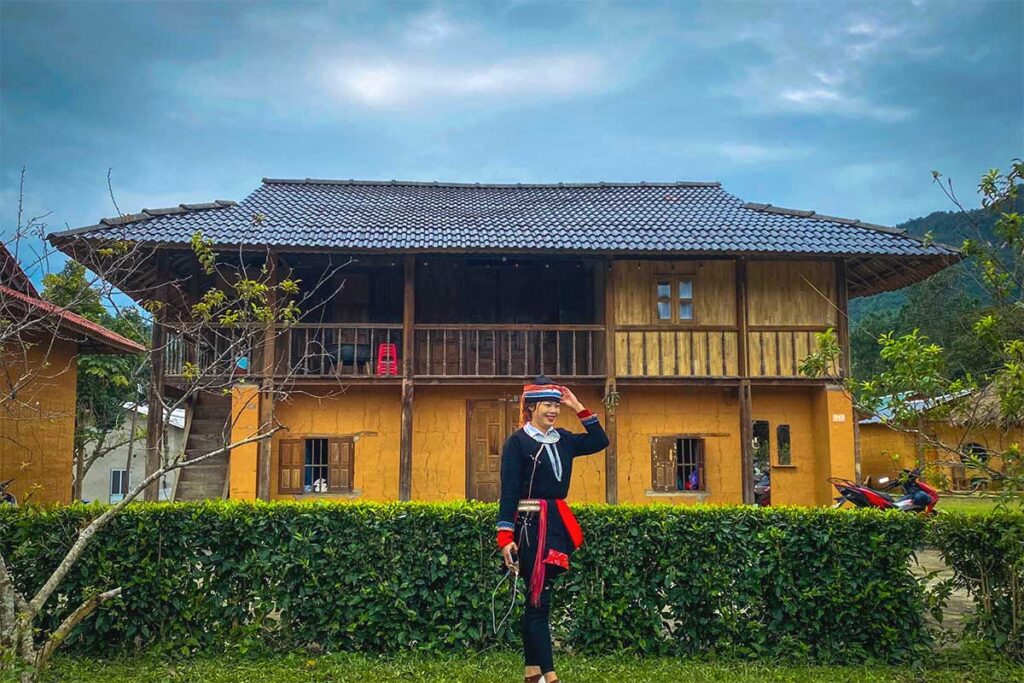
The waterfall itself isn’t very large and doesn’t have a big swimming pool, but it flows beautifully through a forested setting in the rainy season. It’s more of a place to cool off, sit in a small stream, or enjoy the peaceful walk. In the dry season, water levels can be very low, and the path may get muddy or slippery.
Reaching the falls takes about 10–15 minutes on foot. The trail isn’t marked, but locals can point you in the right direction if you ask. It’s best to leave your motorbike at the top of the village and walk down — the road is steep and can be difficult to ride, especially after rain.
Travel Tip: If you cross a stream while walking, you’ve missed the turn. Double-check your route or ask someone in the village.
3. Number 6 Waterfall
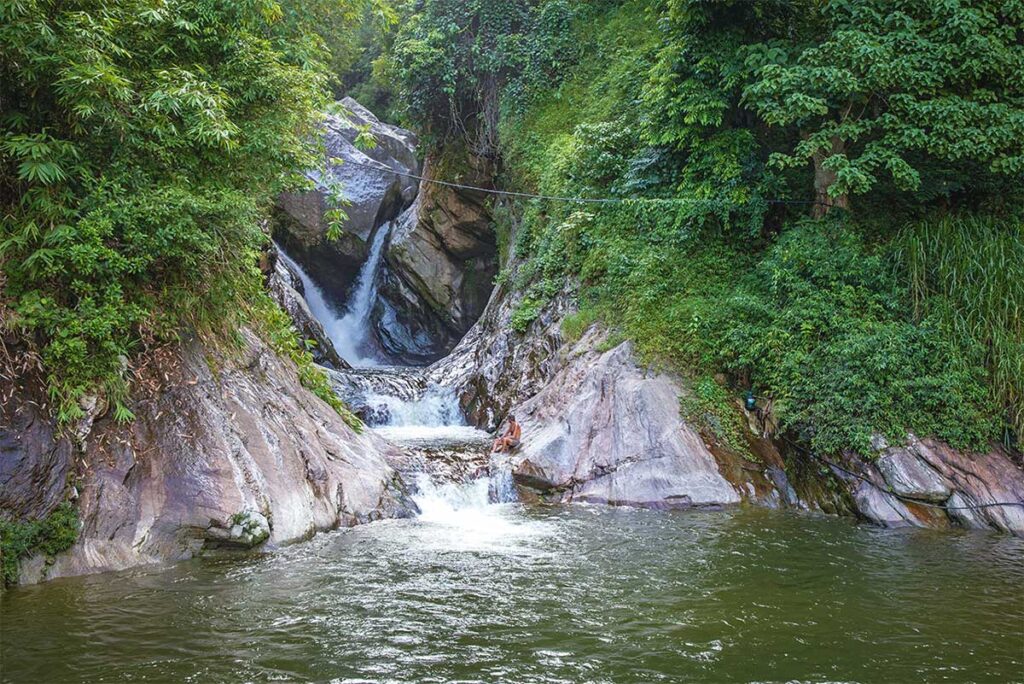
Only 6 km from Ha Giang City, this waterfall — known as “Number 6” — is surprisingly quiet given how close it is to town. It’s often overlooked by people who are either just starting or finishing the loop. But it makes a great first or last stop, especially if you want a swim before heading into (or out of) the mountains.
The waterfall flows from a dense jungle and drops into a deep natural pool, perfect for swimming on a hot day. The area is peaceful, surrounded by lush vegetation and small farms, and the approach road passes scenic rice fields and stilt houses.
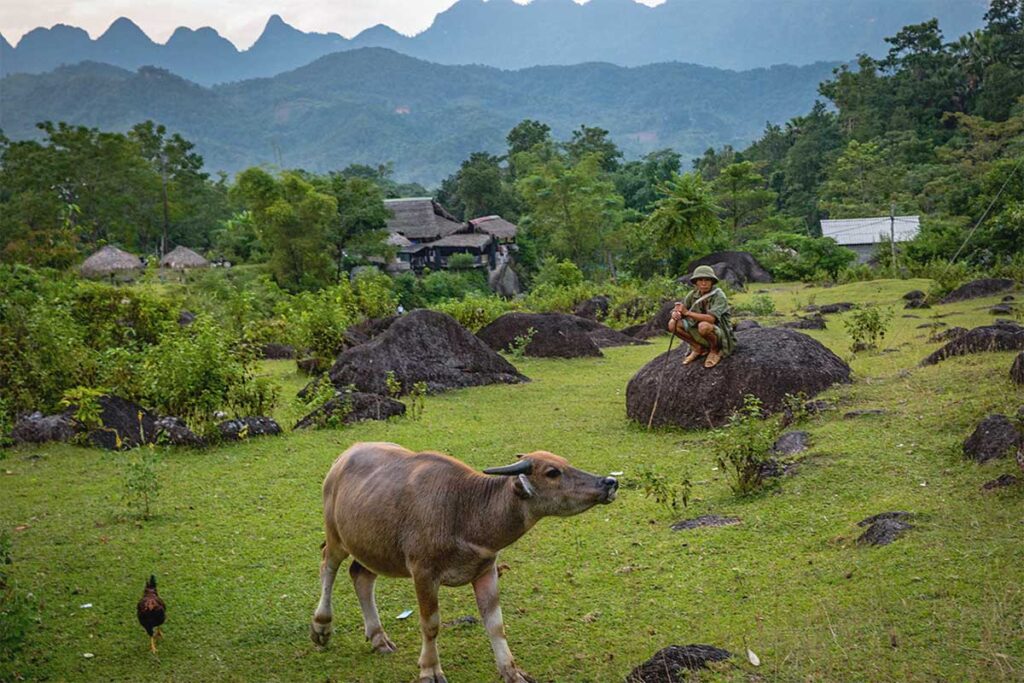
Getting here can be a bit tricky. Google Maps isn’t reliable for the last stretch. From QL2, take the turn-off and follow a concrete lane until it forks — then take the left path up the hill, not the right as the map suggests. You’ll eventually see a red sign for motorbike parking. From there, walk a short trail, cross the river by stepping over rocks, and follow the path along the embankment to the waterfall.
Travel Tip: There’s a rustic camp/restaurant nearby called Base Camp, where you can grab a cold drink and enjoy the views after your swim.
4. A Boong Waterfall
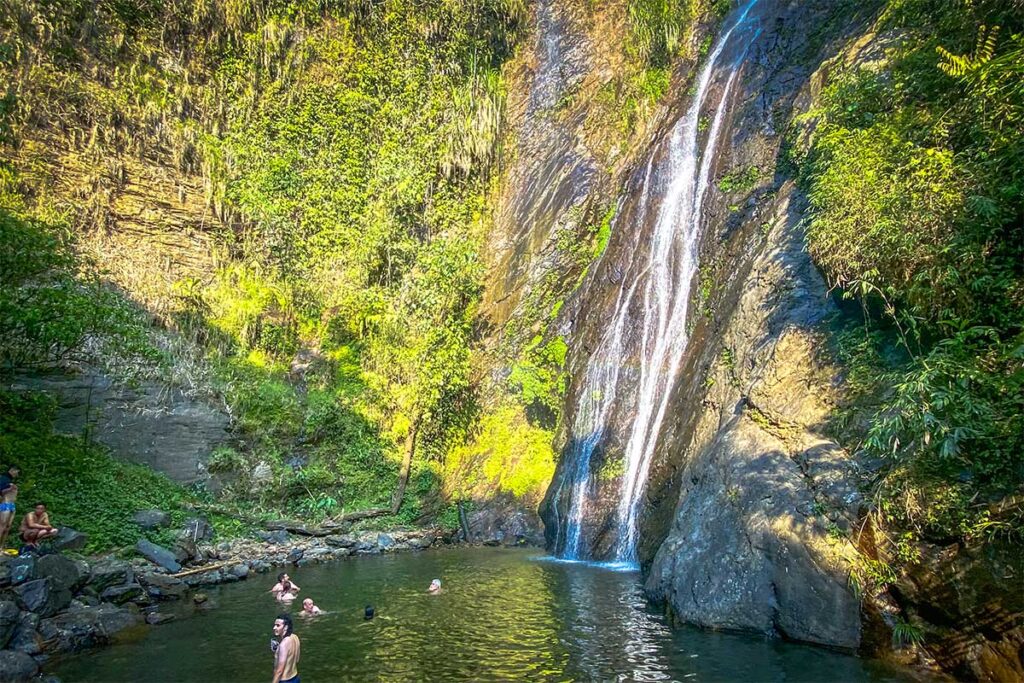
A Boong is a small but scenic waterfall located along the lesser-used route between Du Gia and Ha Giang City. Many riders now prefer this alternative to avoid backtracking through Quan Ba or Yen Minh. If you’re already planning to visit Du Gia, this route — and A Boong Waterfall — fits in nicely.
The waterfall itself isn’t big, but it’s surrounded by dense forest and feels secluded. On a hot day, it’s a great spot for a quick swim or a quiet break. The water is cold, especially outside the summer months, so it’s more refreshing than relaxing.
You’ll need to take a short uphill hike to reach it, but the path is manageable and not very long. Most people find the walk enjoyable, and many report having the place entirely to themselves. It’s a peaceful stop and a great way to break up the drive back to Ha Giang.
Travel Tip: Be aware that the exact location on Google Maps can be inaccurate. Look out for signs or ask locals if you’re unsure.
Other waterfalls in Ha Giang Province
The Ha Giang Loop only passes through part of the province — but Ha Giang is much larger than most travelers realize. If you’re venturing further out or combining Ha Giang with places like Bac Ha or Tuyen Quang, there are a few more impressive waterfalls worth knowing about. These aren’t on standard routes and are only realistic if you’re on a custom road trip or have several extra days.
1. Tien Waterfall (Xin Man District)
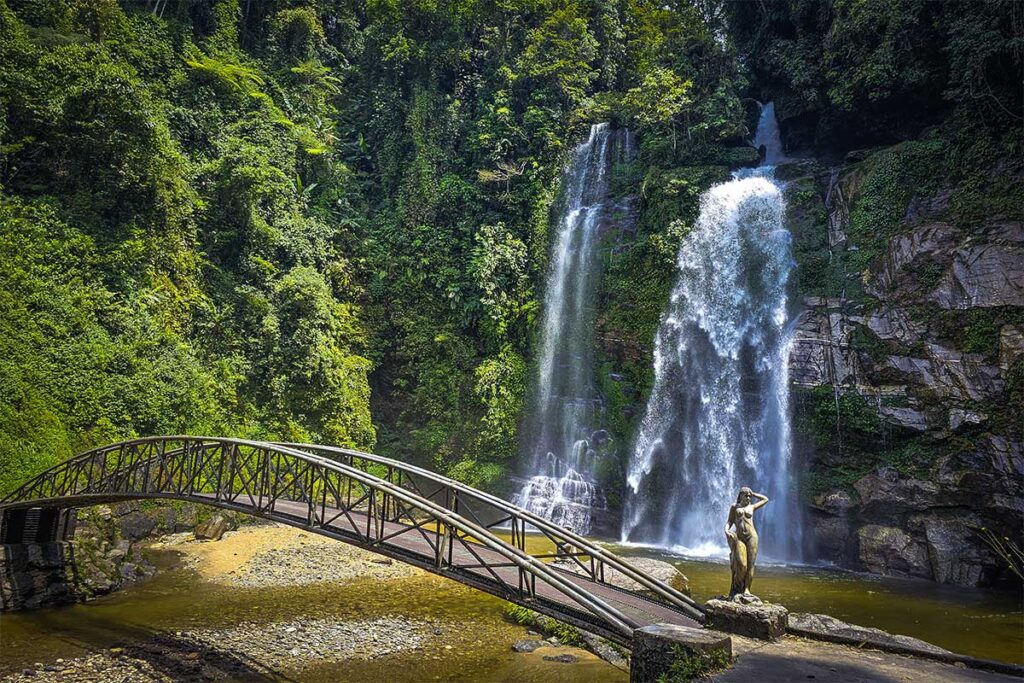
Tien Waterfall, also known as Deo Gio Waterfall or Doi Waterfall, is tucked away in Xin Man district — far west of the Ha Giang Loop. It’s best reached when connecting remote routes between Hoang Su Phi, Bac Ha, and Coc Pai. The road to get there is absolutely stunning, winding through highland villages, forested hills, and scenic valleys.
The waterfall itself is one of the most beautiful in Ha Giang. A strong stream plunges down a high cliff into a deep natural pool, surrounded by dense jungle. You can cross a small bridge over the stream or wade through the water during the dry season. The setting is quiet, peaceful, and rarely crowded.
Getting there involves a walk down stone steps, which can be very slippery — especially after rain. The path is not well maintained, but it’s short and manageable if you’re careful. Entry costs around 20,000 VND.
Travel Tip: Combine this stop with the Nam Dan ancient stone field nearby, or as part of a loop through Lao Cai province and Bac Ha.
2. Nam Tau Waterfall (Border of Tuyen Quang & Ha Giang)
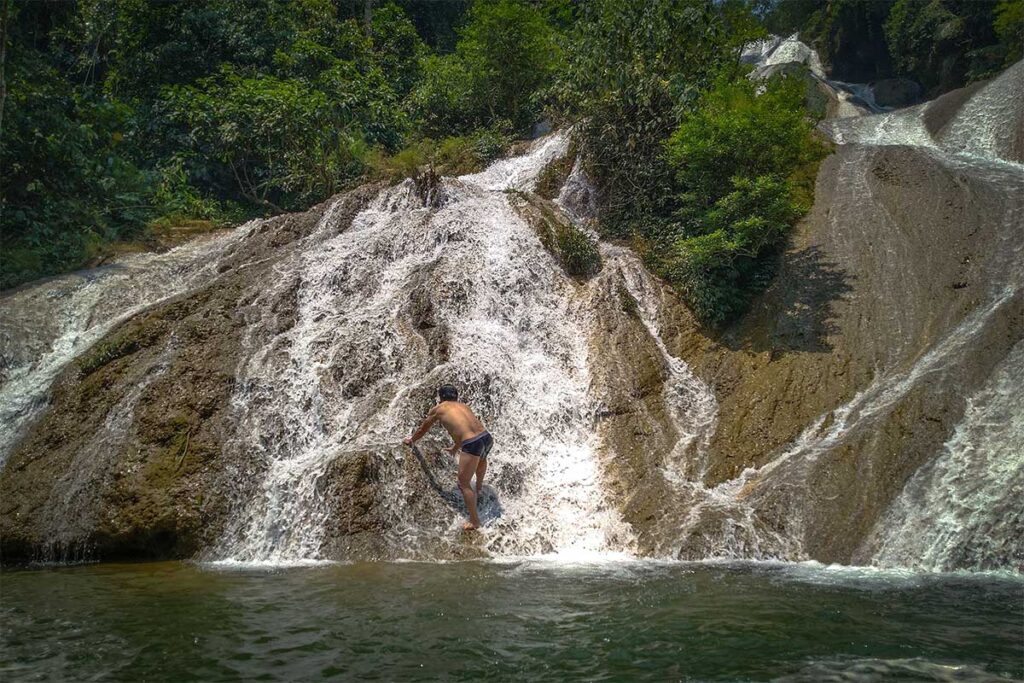
Nam Tau Waterfall lies right on the border of Ha Giang and Tuyen Quang provinces, deep in a quiet area that very few travelers pass through. It’s close to Ban Ba village, where a few basic homestays are available, but otherwise, the surroundings are remote and undeveloped.
The waterfall itself flows over multiple tiers through a forested gorge. The setting is wild and scenic, but the entrance is unmarked and difficult to find — you’ll likely need to ask locals for directions. The nearest recognizable landmark is a buffalo barn, where you can park before walking 150 meters to reach the top of the falls, then descend a slope to view the base.
This spot sees almost no tourism and may be affected by litter in some seasons. Still, for off-the-grid explorers or those coming through Tuyen Quang by chance, it can be a surprising highlight.
Tips for exploring Ha Giang’s waterfalls
Waterfalls are one of the most refreshing and unexpected highlights of the Ha Giang Loop — but to fully enjoy them, a bit of planning goes a long way. Whether you want a quick stop to cool your feet or a full swim after a long ride, these tips will help you make the most of the experience.
Getting around
You can explore the Ha Giang Loop by motorbike, on the back of an Easy Rider, or by car — all options give you access to most waterfalls, though some are easier to reach than others. Most falls are just off the main loop or on common detour routes.
The loop itself is flexible. You can take different roads depending on your route and interests, so if waterfalls are a priority, plan your itinerary with that in mind. At least 3 days is the minimum time to do the loop, but 4 days gives you more breathing room — especially if you want to swim, take photos, or explore quieter spots off the beaten track.
What to bring
If you’re planning to swim, pack swimwear and a towel. A quick-drying towel is especially handy if you’re traveling by motorbike — it dries fast, packs small, and won’t stay wet in your bag.
Don’t expect any facilities at the waterfalls — no changing rooms, lockers, or showers. You’ll be changing behind trees or rocks, so wear something easy to slip on and off. On cooler days or in the early dry season, bring an extra layer or light jacket to warm up after getting out of the water.
Stay near a waterfall
One of the easiest ways to enjoy a swim without rushing is to stay overnight near a waterfall. Du Gia Waterfall is surrounded by homestays in the village, and Nam Dam village (near the Nai Nam Dam Waterfall) also offers local stays with great food and warm hospitality.
Planning your stop this way means you can arrive in the afternoon, cool off in the waterfall, take a warm shower back at your homestay, and relax for the evening. It’s a simple but rewarding way to end a day on the loop.
The Ban Gioc Waterfall in Cao Bang
If you’re serious about waterfalls, it’s hard to beat Ban Gioc Waterfall — Vietnam’s largest and most iconic cascade. It’s not in Ha Giang, but just next door in Cao Bang province, and well worth the trip if you have time to extend your journey.
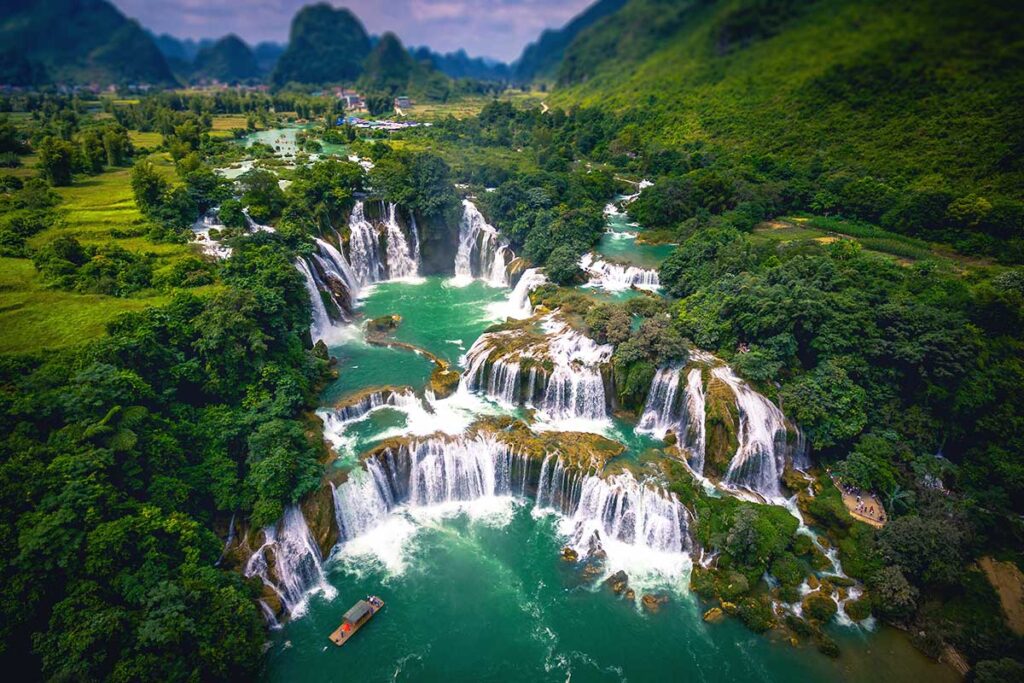
Ban Gioc sits right on the border with China, thundering down a wide rock face into turquoise pools surrounded by limestone peaks. It’s a completely different experience from the smaller jungle falls along the Ha Giang Loop — more dramatic, more powerful, and more developed for tourism, yet still not overrun.
You can combine Ha Giang and Cao Bang as part of a bigger northern Vietnam road trip. The drive between the two takes several hours and requires some route planning, but the landscapes along the way — winding passes, quiet valleys, ethnic villages — make the journey just as memorable as the destination.
Ha Giang – Cao Bang & Ban Gioc Waterfall – Ba Be Lake
- Experience: Ha Giang’s mountain passes and Ban Gioc Waterfall on one scenic northern route.
- All-Inclusive: All transfers from Hanoi, local guides, accommodations, and Ba Be Lake visit.
Cao Bang also offers much more than just Ban Gioc: ancient caves, remote mountain roads, and untouched countryside rarely seen by international travelers. If you’re into waterfalls, nature, and off-the-beaten-track travel, it’s one of the most rewarding provinces to explore.
Read more in our full guide: Things to do in Cao Bang
